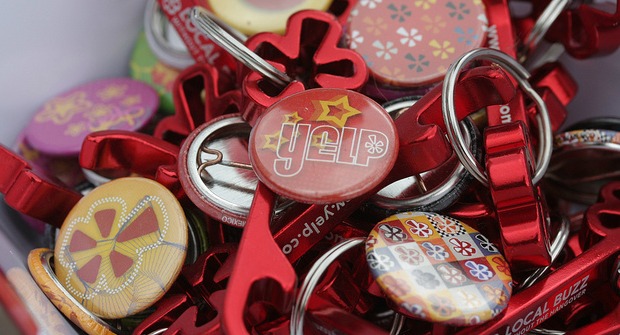leadership
Does Swag Work?

Look around your office. Chances are, you’ve got a logo item somewhere. A pen, a bottle opener, a coffee mug, a tote bag or umbrella--something imprinted with the name of a business, nonprofit organization, or school.
You’re not alone. In a 2009 survey by PPAI Research, 3 out of 4 consumers reported having at least one promotional product in their workspace. In fact, nearly 6 in 10 claimed they had between two and eleven products, or more.
This year, the U.S. promotional products industry is estimated to be a $17.4 billion market. To put that figure in perspective, American wineries have annual revenues of $14 billion, breakfast cereal manufacturers have revenues of $12 billion, and movie ticket sales are about $10 billion. Americans will spend more on swag this year than they do on amusement parks and arcades, more than on dry cleaning, more than on coffee shops including Starbucks and Peet’s.
Swag sells. But, why? And more importantly, can it really do much to promote your brand?
For starters, the range of promotional products is far broader than their “tchotchke” reputation. Sure, you can put your logo on a stress ball or plastic clappers, but you could also give out silver-tipped wine stoppers, a leather portfolio, or a name-brand golf shirt, to give just a few options. Just as with TV and radio ads, some promo articles are more tasteful than others. You might be surprised to learn that, in 2010, 31% of promotional sales were of wearable items like shirts, jackets, and hats; 7% were of drinkware; and less than 2% were of toys and games.
Second, and significantly in tough economic times, promotional products are accessible. Not every enterprise can afford a radio spot or a television ad, but a budget of several hundred dollars will get you into the promotional products game--and promo items are persistent marketing, designed to last and deliver your message repeatedly, over time.
Plus, people like presents: PPAI found that when it comes to collecting promotional items at tradeshows and other events, a quarter of respondents would pick up the item, regardless of what it was. Freebies also trigger what researchers call the reciprocity effect--the conditioned cultural response to return the kindness of a gift--which can manifest itself in better response rates, repeat business, and referrals.
Finally, promotional items are almost always delivered personally. In an environment that puts a premium on one-to-one marketing and interaction and engagement with customers, promotional products are a way to connect directly with your target audience.
So, while swag may not seem to command cachet, it punches above its weight.
Here are four tips for making sure you score with your promotional products:
Focus on utility first. Your logo is going to be the same, no matter which product you choose. But your item’s success as a marketing tool depends on whether its recipient will actually use it. A polo shirt that languishes in your customer’s drawer is not serving your brand. Neither is that stuffed animal you thought was so cute--and your client gave to Goodwill. Remember who your giveaway is destined for, and choose something that will work well for them. Ask yourself, would my target recipient ever buy this item for him or herself? The crowd at a beer-tasting event is more likely to happily stick a bottle-opener keychain in their pocket than get excited about a mouse pad.
Invest in staying power. Don’t be a Scrooge when it comes to investing in your item’s durability. One of the best things about promotional products is their potential for persistent communication. Suppose you’ve selected a 29-cent pen. Its ink cartridge will run out in three months. Why not choose an 80-cent pen designed to last a year? Chances are, the marginal cost difference is trifling compared to your overall marketing spend--and you would quadruple the amount of time that pen will be working for you.
Don’t overspend. You don’t need to pick an expensive item. Aim for quality instead. Your gift itself--not the giveaway’s retail value—is what triggers the reciprocity effect. If you want to get your brand before large numbers of people, a small, high-quality item, purchased in bulk, can be a marketing bargain. And, as with many other sectors, it pays to comparison shop. The undecorated products available on the market are often identical from one distributor to the next; many times, they come from the exact same manufacturers. But their prices can vary tremendously.
Make your message meaningful. A coffee mug is just a coffee mug, until it has your logo on it. Make sure whatever you put on your item conveys the most important information. If your business relies on direct contact with customers, include your phone number or email. If your nonprofit relies on donors’ identification with your mission, choose a slogan that reminds them every day. And while it’s great if your item aligns with your work, remember, utility comes first. Give a gift your customer will genuinely appreciate, and the message will speak for itself.
Author Jerry McLaughlin is CEO of Branders.com, the world’s largest online promotional products company; he can be reached by email at JerryMcLaughlin@branders.com.
[Image: Flickr user Yelp.com]












